
Home - Search - Browse - Alphabetic Index: 0- 1- 2- 3- 4- 5- 6- 7- 8- 9
A- B- C- D- E- F- G- H- I- J- K- L- M- N- O- P- Q- R- S- T- U- V- W- X- Y- Z
Apollo 11
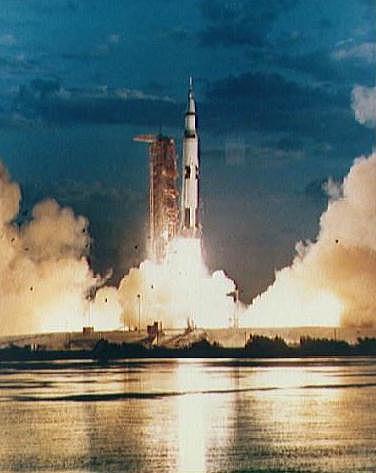
Saturn V 1
Credit: NASA
AKA: Columbia/Eagle. Launched: 1969-07-16. Returned: 1969-07-24. Number crew: 3 . Duration: 8.14 days. Location: National Air and Space Museum (Smithsonian Institution), Washington, DC.
Apollo 11 (AS-506) - with astronauts Neil A. Armstrong, Michael Collins, and Edwin E. Aldrin, Jr., aboard - was launched from Pad A, Launch Complex 39, KSC, at 9:32 a.m. EDT July 16. The activities during earth-orbit checkout, translunar injection, CSM transposition and docking, spacecraft ejection, and translunar coast were similar to those of Apollo 10.
At 4:40 p.m. EDT July 18, the crew began a 96-minute color television transmission of the CSM and LM interiors, CSM exterior, the earth, probe and drogue removal, spacecraft tunnel hatch opening, food preparation, and LM housekeeping. One scheduled and two unscheduled television broadcasts had been made previously by the Apollo 11 crew.
The spacecraft entered lunar orbit at 1:28 p.m. EDT on July 19. During the second lunar orbit a live color telecast of the lunar surface was made. A second service-propulsion-system burn placed the spacecraft in a circularized orbit, after which astronaut Aldrin entered the LM for two hours of housekeeping including a voice and telemetry test and an oxygen-purge-system check.
At 8:50 a.m. July 20, Armstrong and Aldrin reentered the LM and checked out all systems. They performed a maneuver at 1:11 p.m. to separate the LM from the CSM and began the descent to the moon. The LM touched down on the moon at 4:18 p.m. EDT July 20. Armstrong reported to mission control at MSC, "Houston, Tranquility Base here - the Eagle has landed." (Eagle was the name given to the Apollo 11 LM; the CSM was named Columbia.) Man's first step on the moon was taken by Armstrong at 10:56 p.m. EDT. As he stepped onto the surface of the moon, Armstrong described the feat as "one small step for a man - one giant leap for mankind."
Aldrin joined Armstrong on the surface of the moon at 11:15 p.m. July 20. The astronauts unveiled a plaque mounted on a strut of the LM and read to a worldwide TV audience, "Here men from the planet earth first set foot on the moon July 1969, A.D. We came in peace for all mankind." After raising the American flag and talking to President Nixon by radiotelephone, the two astronauts deployed the lunar surface experiments assigned to the mission and gathered 22 kilograms of samples of lunar soil and rocks. They then reentered the LM and closed the hatch at 1:11 a.m. July 21. All lunar extravehicular activities were televised in black-and-white. Meanwhile, Collins continued orbiting moon alone in CSM Columbia.
The Eagle lifted off from the moon at 1:54 p.m. EDT July 21, having spent 21 hours 36 minutes on the lunar surface. It docked with the CSM at 5:35 p.m. and the crew, with the lunar samples and film, transferred to the CSM. The LM ascent stage was jettisoned into lunar orbit. The crew then rested and prepared for the return trip to the earth.
The CSM was injected into a trajectory toward the earth at 12:55 a.m. EDT July 22. Following a midcourse correction at 4:01 p.m., an 18-minute color television transmission was made, in which the astronauts demonstrated the weightlessness of food and water and showed shots of the earth and the moon.
At 12:15 p.m. EDT July 24 the Apollo 11's command module Columbia splashed down in the mid-Pacific, about 24 kilometers from the recovery ship U.S.S. Hornet. Following decontamination procedures at the point of splashdown, the astronauts were carried by helicopter to the Hornet where they entered a mobile quarantine facility to begin a period of observation under strict quarantine conditions. The CM was recovered and removed to the quarantine facility. Sample containers and film were flown to Houston.
All primary mission objectives and all detailed test objectives of Apollo 11 were met, and all crew members remained in good health.
Official NASA Account of the Mission from Where No Man Has Gone Before: A History of Apollo Lunar Exploration Missions, by W. David Compton, published as NASA SP-4214 in the NASA History Series, 1989.
At 9:32 a.m. Eastern daylight time on July 16, 1969, Apollo 11 left Launch Complex 39A at Kennedy Space Center, bound for the moon. Four days later, at 4:18 p.m. EDT on July 20, Neil Armstrong skilfully set the lunar module Eagle down in the Sea of Tranquility and reported, "Houston, Tranquility Base here. The Eagle has landed." For the next 10 minutes Armstrong and Aldrin were occupied with several post-landing procedures, reconfiguring switches and systems. Armstrong found time to report to Mission Control what he had been too busy to tell them during the landing: that he had manually flown the lunar module over the rockstrewn crater where the automatic landing system was taking it. Then he made his first quick-look science report:
"We'll get to the details of what's around here, but it looks like a collection of just about every variety of shape, angularity, granularity, about every variety of rock you could find. . . . There doesn't appear to be too much of a general color at all. However, it looks as though some of the rocks and boulders, of which there are quite a few in the near area, it looks as though they're going to have some interesting colors to them. . . . "
After giving Houston as many clues as he could to the location of their module, he added some more description:
"The area out the left-hand window is a relatively level plain cratered with a fairly large number of craters of the 5- to 50-foot variety, and some ridges - small, 20, 30 feet high, I would guess, and literally thousands of little 1- and 2-foot craters around the area. We see some angular blocks out several hundred feet in front of us that are probably 2 feet in size and have angular edges. There is a hill in view, just about on the ground track ahead of us. Difficult to estimate, but might be half a mile or a mile. "
Armstrong and Aldrin then started preparing their spacecraft for takeoff, setting up critical systems to be ready in case something happened and they had to leave the lunar surface quickly. A short break in this activity gave Armstrong a chance to pass along more information about the landing site:
". . . The local surface is very comparable to that we observed from orbit at this sun angle, about 10 degrees sun angle, or that nature. It's pretty much without color. It's . . . a very white, chalky gray, as you look into the zero-phase line [directly toward the sun]; and it's considerably darker gray, more like . . . ashen gray as you look out 90 degrees to the sun. Some of the surface rocks in close here that have been fractured or disturbed by the rocket engine plume are coated with this light gray on the outside; but where they've been broken, they display a dark, very dark gray interior; and it looks like it could be country basalt. "
Setting up the spacecraft systems took another hour and a half to complete; then they were ready to get out and explore. The flight plan called for them to eat and then rest for four hours, but Aldrin called Mission Control to recommend starting their surface exploration in about three hours' time. Houston concurred. Although they had been awake almost 11 hours and had gone through some stressful moments during the landing, it seemed too much to expect the first men on the moon to take a nap before they made history.
While Armstrong and Aldrin tended to their postlanding chores, Mike Collins, orbiting 60 nautical miles (112 kilometers) overhead in the command module Columbia, had little to do. Houston enlisted his aid in an attempt to locate Eagle, giving him the best map coordinates they could derive from the sketchy information available. With his navigational sextant Collins scanned several spots, without success; Columbia passed over the landing site too rapidly to allow him to search the area thoroughly and he never found the lunar module. Determination of its exact location had to wait for postmission analysis of Armstrong's descriptions of the area and examination of the spacecraft's landing trajectory.
Getting ready to leave the lunar module took longer than the crew had anticipated. It was after 9:30 p.m. in Houston, an hour and a half later than they had hoped, when they opened the hatch. Armstrong carefully worked his way out onto the "porch," then climbed down the ladder, pausing on the lowest rung to comment on the texture of the surface and the depth to which the footpads had penetrated. At 9:56 p.m. he stepped onto the moon's surface, proclaiming, "That's one small step for man, one giant leap for mankind" - inadvertently omitting an "a" before "man" and slightly changing the meaning he intended to convey.
Armstrong made a cursory inspection of the lunar module and reported his reactions to the new environment. Aldrin then lowered a camera on the lunar equipment carrier - a clothesline and pulley arrangement that seemed out of place in the high-technology environment of Apollo - which Armstrong immediately began using. Mission Control reminded him to scoop up the contingency sample, which he did. "I'll try to get a rock in here. Just a couple." He noted that the collecting tool met resistance after penetrating a short distance into the surface material. He then stowed the sample in a bag that he tucked into a pocket of his suit. To the scientists on earth he remarked, "Be advised that a lot of the rock samples out here, the hard rock samples, have what appear to be vesicles in the surface. Also, I am looking at one now that appears to have some sort of phenocryst."
Aldrin then joined Armstrong on the surface, and they spent the next several minutes inspecting the landing craft and reporting on its condition, adjusting to the low lunar gravity and trying various ways of getting around on the surface. After a brief commemorative ceremony (reading the plaque attached to the lunar module) and a short conversation with President Richard Nixon, they began unloading and emplacing the scientific instruments and collecting samples. They supplemented earth's limited television view of their activities with descriptions of what they were seeing and doing. On a couple of occasions they acted like field geologists. Aldrin reported that he saw a rock that sparkled "like some kind of biotite," but he "would leave that to further analysis." After closely examining some rounded boulders near the spacecraft, Armstrong said they looked "like basalt, and they have probably two percent white minerals in them. . . . And the thing that I reported as vesicular before, I don't believe that any more. . . . they look like little impact craters where BB shot has hit the surface."
The geologists in Houston watching this surface activity on television were quite pleased with the astronauts' performance. At one point Armstrong disappeared from the field of view of the TV camera, causing some momentary anxiety at his apparent departure from the plan. It turned out that some unusual rocks had attracted his attention and he had gone off a few meters to collect them. That was exactly the kind of thing the geologists had hoped people on the moon would do. By the time the crew had taken two core samples, again experiencing difficulty in driving a sampling tool into the surface, and filled their sample return containers, Houston notified them that it was time to wind up their activity. Just before midnight CapCom Bruce McCandless told Aldrin to "head on up the ladder," and at 12:11 a.m. Houston time both men and their samples were back in the lunar module and the hatch was sealed. Humanity's first excursion on the surface of another celestial body had lasted 2 hours, 31 minutes, and 40 seconds.
Back inside the lunar module, Armstrong and Aldrin removed their lunar surface suits and portable life-support systems and used up their remaining film. Houston passed up some more instructions in preparation for liftoff and tentatively signed off for the night, but before long CapCom Owen Garriott, who had relieved McCandless, came on the line with some questions from the scientists about the nature of the surface and the problems in driving sampling tools into the surface. Three hours after they returned to the lunar module, the lunar explorers finally were able to turn in for a few hours of fitful sleep.
Next morning Armstrong, Aldrin, and Collins spent most of their time setting up Eagle and Columbia for liftoff and rendezvous. Before the lunar module left the moon, however, Armstrong gave Mission Control a detailed description of the landing approach path and landing area, in the hope of helping scientists locate their exact landing spot, and summarized the characteristics of the soil and rocks around the area.
Liftoff and rendezvous went smoothly. When the two spacecraft were locked together Collins cracked Columbia's oxygen supply valve and Aldrin opened the lunar module's vent valve, to create a gas flow into the LM when the hatches were opened - part of the procedure to minimize back-contamination-while Aldrin and Armstrong vacuumed the lunar dust from their suits as best they could. Their vacuum cleaner, a brush attached to the exhaust hose of the LM suit system, was not very powerful and the tenacious dust came off only with difficulty. There was not nearly as much loose dust in the lunar module as they had expected when they returned from the surface; evidently it stuck tightly to whatever it touched. They passed the rock boxes and other items over to Collins and then clambered into the command module, where they removed their suits and stowed them in the bags provided. After jettisoning the lunar module and straightening up the command module, the three astronauts settled in for an uneventful trip back to earth.
In the early morning hours of July 24, 8 days, 3 hours, 18 minutes, and 18 seconds after leaving Kennedy Space Center, Columbia plopped down into the Pacific Ocean about 200 nautical miles (370 kilometers) south of Johnston Island. Recovery crews from the U.S.S. Hornet arrived quickly and tossed the biological isolation garments into the spacecraft. After the cocooned astronauts emerged from the spacecraft the swimmers swabbed the hatch down with Betadine (an organic iodine solution); then astronauts and recovery personnel decontaminated each other's protective garments with sodium hypochlorite solution. The biological isolation garments were not uncomfortable in the recovery raft, but aboard the helicopter they began accumulating heat. Both Collins and Armstrong felt that they were approaching the limit of their tolerance by the time they reached the ship. An hour after splashdown they were inside the mobile quarantine facility. As soon as they had changed into clean flight suits, the astronauts went to the large window at the rear end of the mobile quarantine facility to accept the nation's congratulations from President Nixon, who had flown out to the Hornet to meet them.
Meanwhile, recovery crews brought Columbia on board and connected it to the astronauts' temporary home by means of a plastic tunnel. Through this, the film magazines and sample return containers were taken into the quarantine trailer, then passed out through a decontamination lock. Sample return container no. 2, holding the documented sample, was packed in a shipping container along with film magazines and tape recorders and flown to Johnston Island, where it was immediately loaded aboard a C-141 aircraft and dispatched to Ellington Air Force Base near MSC. Six and a half hours later the other sample return container was flown to Hickam Air Force Base, Hawaii, and thence to Houston.
More at: Apollo 11.
Family: Manned spaceflight. People: Aldrin, Armstrong, Collins. Country: USA. Spacecraft: Apollo CSM. Projects: Apollo, Lunar L3. Launch Sites: Cape Canaveral. Agency: NASA Houston. Bibliography: 4929, 5051, 7762.
 | Apollo 11 Credit: www.spacefacts.de |
 | Apollo 11 Apollo 11 Patch Credit: NASA |
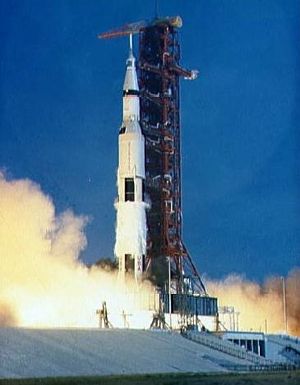 | Apollo 11 Lift-off of the Apollo 11 lunar landing mission Credit: NASA |
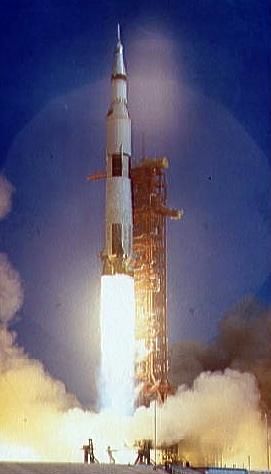 | Apollo 11 Lift-off of the Apollo 11 lunar landing mission Credit: NASA |
 | Apollo 11 Lift-off of the Apollo 11 lunar landing mission Credit: NASA |
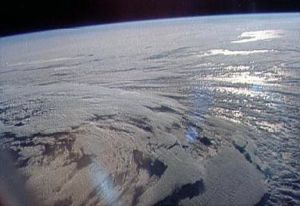 | Apollo 11 View of Earth showing clouds over water taken by Apollo 11 crewmembers Credit: NASA |
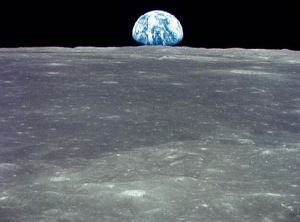 | Apollo 11 View of Earth rising over Moon's horizon taken from Apollo 11 spacecraft Credit: NASA |
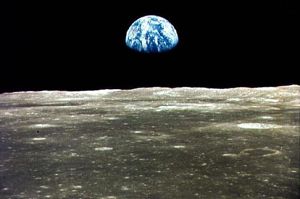 | Apollo 11 View of Earth rising over Moon's horizon taken from Apollo 11 spacecraft Credit: NASA |
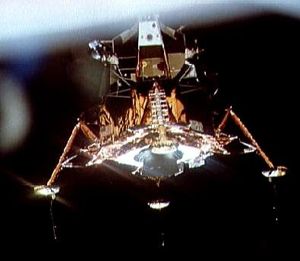 | Apollo 11 View Lunar module from the Command module before its descent to lunar surface Credit: NASA |
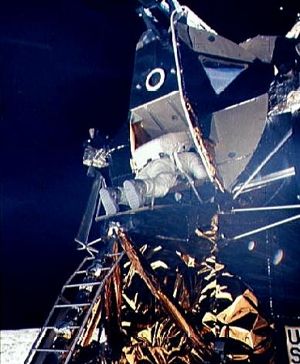 | Apollo 11 Astronaut Edwin Aldrin egresses lunar module on lunar surface Credit: NASA |
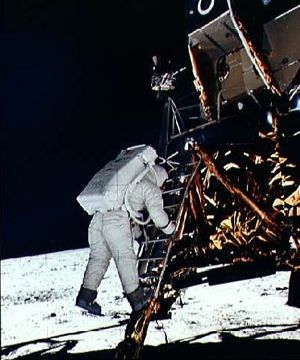 | Apollo 11 Astronaut Edwin Aldrin descends steps of Lunar Module ladder to walk on moon Credit: NASA |
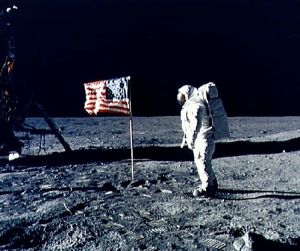 | Apollo 11 Astronaut Edwin Aldrin poses for photograph beside deployed U.S. flag Credit: NASA |
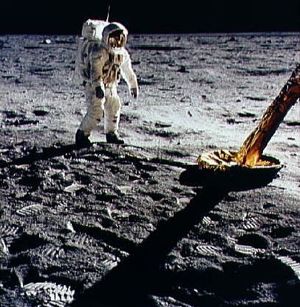 | Apollo 11 Astronaut Edwin Aldrin walks on lunar surface near leg of Lunar Module Credit: NASA |
 | Apollo 11 Astronaut Edwin Aldrin prepares to deploy EASEP on surface of moon Credit: NASA |
 | Apollo 11 Astronaut Edwin Aldrin after deployment of EASEP on surface of moon Credit: NASA |
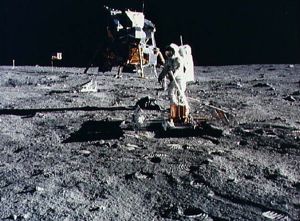 | Apollo 11 Astronaut Edwin Aldrin deploying the EASEP on surface of moon Credit: NASA |
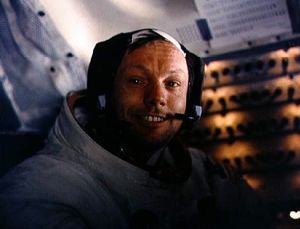 | Apollo 11 View of Astronaut Neil Armstrong in Lunar Module Credit: NASA |
 | Apollo 11 Interior view of Apollo 11 Lunar Module showing displays and controls Credit: NASA |
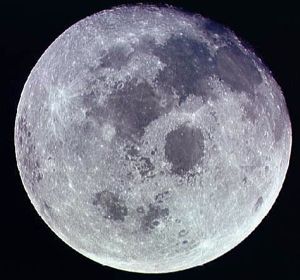 | Apollo 11 View of a full Moon photographed from Apollo 11 spacecraft Credit: NASA |
1965 May 16-June 15 - .
- Preliminary Apollo Reliability Report - .
Nation: USA.
Program: Apollo.
Flight: Apollo 11,
Apollo 204.
Spacecraft: Apollo CSM,
CSM Block I.
North American released a preliminary report, "Apollo Reliability Modeling Documentation," in response to an action item assigned to MSC by the President's Scientific Advisory Committee (PSAC) Space Technology Panel at an Apollo program reliability briefing for the panel in January. Additional Details: here....
1967 September 20 - .
- Proposed sequence of Apollo missions leading to a lunar landing mission - .
Nation: USA.
Program: Apollo.
Flight: Apollo 11,
Apollo 12,
Apollo 15,
Apollo 204.
Spacecraft: Apollo LM.
MSC proposed to the NASA Office of Manned Space Flight a sequence of missions leading to a lunar landing mission. The sequence included the following basic missions:
- A - Saturn V/unmanned CSM development
- B - Saturn IB/unmanned LM development
- C - Saturn IB/manned CSM evaluation
- D - Saturn V/manned CSM and LM development (A dual Saturn IB mission would be an alternative to the Saturn V for mission D)
- E - CSM/LM operations in high earth orbit
- F - Lunar orbit mission
- G - Lunar landing mission (like Apollo 11)
- H - Lunar landing mission (Apollo 12, 13, and 14)
- I - Reserved for lunar survey missions (not used)
- J - Lunar landing missions, upgraded hardware (Apollo 15, 16, and 17)
1967 October 20 - .
- Grumman organizational changes to meet delivery date for Apollo LM-3 - .
Nation: USA.
Program: Apollo.
Flight: Apollo 11.
Spacecraft: Apollo LM.
In an effort to meet a mid-April 1968 delivery date for LM-3, Grumman made a number of organizational changes. Top level direction was strengthened by adding experienced managers in strategic positions and by reinforcing the Grumman LM organization with more management talent and additional test personnel. A spacecraft director for each vehicle was brought into the program for LM-2, -3, -4, and -5, with responsibility for overall Grumman support of individual vehicles from cradle to grave.
1967 November 2 - .
- Apollo LM insulation susceptible to degradation from cabin leakage during pressurized conditions - . Nation: USA. Related Persons: Faget. Program: Apollo. Flight: Apollo 11. Spacecraft: Apollo LM, LM Structural. Maxime A. Faget, MSC Director of Engineering and Development, told the ASPO Manager that he had reviewed the LM insulation status and concluded that "the present design is susceptible to degradation from cabin leakage during pressurized conditions. . Additional Details: here....
1967 December 17 - .
- Apollo LM-5 window shattered during initial pressurization test - .
Nation: USA.
Program: Apollo.
Flight: Apollo 11.
Spacecraft: Apollo LM,
LM Ascent Propulsion,
LM Structural.
A LM test failed in the Grumman ascent stage manufacturing plant December 17. A window in LM-5 shattered during its initial cabin pressurization test, designed to pressurize the cabin to 3.9 newtons per square centimeter (5.65 pounds per square inch). Both inner and outer windows and the plexiglass cover of the right-hand window shattered when the pressure reached 3.5 newtons per sq cm (5.1 psi). An MSC LM engineer and Corning Glass Co. engineers were investigating the damage and cause of failure.
1968 March 18 - .
- Relaxed review procedures on Apollo LM-4 and LM-5 - . Nation: USA. Program: Apollo. Flight: Apollo 11. Spacecraft: Apollo LM. Samuel C. Phillips, NASA Apollo Program Director, expressed concern to ASPO Manager George Low that relaxed review procedures on LM-4 and LM-5 might tend to delay identification and resolution of problems. . Additional Details: here....
1968 June 7 - .
- Apollo LM descent stage heatshield and thermal blanket problems - .
Nation: USA.
Related Persons: Faget.
Program: Apollo.
Flight: Apollo 11.
Spacecraft: Apollo LM,
LM Descent Propulsion.
ASPO Manager George M. Low and others from MSC met with Grumman's LM engineering staff, headed by Thomas J. Kelly, to discuss the descent stage heatshield and thermal blanket problems associated with reduced thrust decay of the descent engine at lunar touchdown. Additional Details: here....
1968 August 28 - .
- Detailed study of Apollo LM-4 for lunar orbit mission - . Nation: USA. Program: Apollo. Flight: Apollo 11. Spacecraft: Apollo LM. NASA asked Grumman to make a detailed study of LM-4 to determine any constraints that might prevent accomplishment of a lunar orbit mission. . Additional Details: here....
1968 December 14 - .
- Functional check of Apollo ALSEP lunar handtools - . Nation: USA. Program: Apollo. Flight: Apollo 11. Spacecraft: Apollo LM, LM ECS. The ASPO Manager asked Wilmot N. Hess, MSC Director of Science and Applications, to devise a crew fit and functional check of lunar handtools before the LM-5 crew training tests. . Additional Details: here....
1969 January 24 - .
- Apollo experiments on visual perception on the moon - .
Nation: USA.
Program: Apollo.
Flight: Apollo 11.
In an exchange of letters, the feasibility and compatibility of experiments covering contrast perception, color perception, and distance estimation on the moon were discussed. Incorporation of the three experiments in the lunar landing mission's detailed test objective "Lunar Environment Visibility" for Apollo 11 was recommended.
1969 February 3 - .
- 12-month plan for Apollo missions - .
Nation: USA.
Program: Apollo.
Flight: Apollo 10,
Apollo 11,
Apollo 12,
Apollo 13,
Apollo 9.
Spacecraft: Apollo LM,
CSM Recovery.
NASA Hq. released a 12-month forecast of manned space flight missions, reflecting an assessment of launch schedules for planning purposes. Five flights were scheduled for the remainder of 1969:
- Apollo 9 - February 28, SA-504, CSM 104, LM-3; manned orbital; up to 10 days' duration; Atlantic recovery.
- Apollo 10 - May 17, SA-505, CSM 106, LM-4; manned lunar mission, Pacific recovery.
- Apollo 11 - SA-506, CSM 107, LM-5; manned lunar mission; up to 11 days' duration; Pacific recovery.
- Apollo 12 - SA-507, CSM 108, LM-6; manned lunar mission; up to 11 days; Pacific recovery.
- Apollo 13 - SA-508, CSM 109, LM-7; manned lunar mission; up to 11 days' duration; Pacific recovery.
1969 March 7 - .
- Radiation survey of Apollo CSM 107 planned - .
Nation: USA.
Program: Apollo.
Flight: Apollo 11.
Spacecraft: Apollo CSM,
CSM Block II.
A radiation survey of CSM 107 was planned to determine if the radiation produced by onboard sources would be of a sufficient level to impair the effectiveness of proposed experiments to measure the natural radiation emitted from the lunar surface. The survey would be conducted at KSC by personnel from the Goddard Space Flight Center.
1969 April 25-26 - .
- Aseptic sampler and a closeup stereo camera for the Apollo 11 flight - . Nation: USA. Program: Apollo. Flight: Apollo 11. Spacecraft Bus: Apollo LM. Spacecraft: Apollo ALSEP. In an exchange of correspondence, Samuel C. Phillips, NASA OMSF, and ASPO Manager George Low, MSC, discussed the possibility of carrying an aseptic sampler and a closeup stereo camera on the Apollo 11 flight. . Additional Details: here....
1969 April 29 - .
- Recommendation to carry an erectable antenna on the Apollo 11 mission - .
Nation: USA.
Program: Apollo.
Flight: Apollo 11.
The NASA Associate Administrator for Manned Space Flight concurred in a recommendation to carry an erectable antenna on the Apollo 11 mission. However, it would be deployed only if required to obtain satisfactory television, voice, telemetry, and biomedical data simultaneously from the lunar surface.
1969 May 8 - . Launch Vehicle: N1.
- Russian only hope is major Apollo failure - .
Nation: Russia.
Related Persons: Keldysh,
Mishin,
Pashkov,
Serbin,
Smirnov.
Program: Lunar L3.
Flight: Apollo 11.
Mishin, Keldysh, Pashkov, Smirnov, and Serbin meet. Some of them are still expecting a big failure in the Apollo programme that will set the Americans back and still make it possible for Russia to be first on the moon. These are black days in the Soviet programme - it is clear to Kamanin that the Americans will successfully land on the moon in July, and the Russians are 2 to 3 years behind.
1969 May 8 - .
- Apollo Back Contamination Documentation and Configuration Control Office established - .
Nation: USA.
Program: Apollo.
Flight: Apollo 11.
The Apollo Back Contamination Documentation and Configuration Control Office was established at MSC to provide a documentation program for any possible contamination from the moon. The program was required by June 15, to meet deadlines for the launch of Apollo 11.
1969 May 16 - .
- Myth 'we were never in the moon race' disseminated by the Soviet Union - .
Nation: Russia.
Related Persons: Babakin,
Keldysh.
Program: Luna,
Apollo,
Lunar L3,
Lunar L1.
Flight: Apollo 11.
Spacecraft Bus: Luna Ye-8.
Spacecraft: Luna Ye-8-5.
Keldysh first revealed the new 'party line' at a press conference on the semi-successful Venera 5 landing on Venus. When asked about Soviet lunar plans, he revealed that Russia would only use robot probes, that it wouldn't risk men's lives in such an endeavour. At the same time Babakin was hard at work finishing the first Ye-8-5 robot lunar soil return spacecraft, to be launched before Apollo 11.
1969 May 19 - .
- Postlanding ventilation filter eliminated for Apollo 12 - .
Nation: USA.
Program: Apollo.
Flight: Apollo 11,
Apollo 12.
Spacecraft: Apollo CSM,
CSM Recovery.
In a telephone conference, MSC personnel and members of the Interagency Committee on Back Contamination agreed to eliminate the requirement for a postlanding ventilation filter for Apollo 12, approve a plan for sterilization of the CM in the Lunar Receiving Laboratory (LRL), release the spacecraft at the same time as the crew release, and approve the LRL Bioprotocol Summary. The ICBC planned to meet on June 5 to complete planning and documentation for Apollo 11.
1969 May 24 - .
- Way clear for Apollo 11 - . Nation: Russia. Program: Lunar L3, Lunar L1. Flight: Apollo 10, Apollo 11. Kamanin writes that Apollo 10 has completed its lunar mission successfully. The way is clear for the final step in American winning the moon race..
1969 May 27 - .
- Manual guidance for TLI on Apollo missions - . Nation: USA. Program: Apollo. Flight: Apollo 10, Apollo 11. Spacecraft: Apollo LM, LM Guidance. Apollo Program Director Sam C. Phillips wrote to MSC regarding a Flight Readiness Review action item on translunar injection (TLI: insertion into a trajectory toward the moon) dispersions after manual guidance for TLI on Apollo missions. . Additional Details: here....
1969 June 3 - .
- Proposed landing sites for Apollo 12 - . Nation: USA. Program: Apollo. Flight: Apollo 11, Apollo 12. Spacecraft: Surveyor. In a report to the ASPO Manager, the Chief of MSC's Systems Engineering Division described Apollo Site Selection Board (ASSB) action on proposed landing sites for the Apollo 12 mission. . Additional Details: here....
1969 June 9-13 - . Launch Vehicle: Saturn V.
- Studies of impact of empty Apollo stages on the lunar surface - .
Nation: USA.
Program: Apollo.
Flight: Apollo 11,
Apollo 12.
Spacecraft: Apollo LM.
Studies were being conducted to determine the feasibility of intentionally impacting an S-IVB stage and an empty LM stage on the lunar surface after jettison, to gather geological data and enhance the scientific return of the seismology experiment. Data would be obtained with the ALSEP seismographic equipment placed on the lunar surface during the Apollo 11 or Apollo 12 flight. MSFC and Bellcomm were examining the possibility of the S-IVB jettison; MSC, the LM ascent stage jettison. Intentional impacting of the ascent stage for Apollo 11 was later determined not to be desirable.
1969 June 9 - .
- Apollo 11 CSM Flight Readiness Review - . Nation: USA. Program: Apollo. Flight: Apollo 11. Spacecraft: Apollo LM, CSM Block II. The CSM 107 (Apollo 11) Flight Readiness Review Board met at MSC. . Additional Details: here....
1969 June 9 - .
- Apollo 11 on schedule - .
Nation: USA.
Program: Apollo.
Flight: Apollo 11.
Preparation of Apollo 11 was on schedule for a July 16 launch date. Lunar landmark and landing site mosaics were delivered for flight crew training. A flight readiness test, begun on June 4, had been completed June 6 despite an MSC Mission Control Center power outage that delayed the test for several hours.
1969 June 13 - .
- Color TV coverage for Apollo 11 approved - .
Nation: USA.
Program: Apollo.
Flight: Apollo 10,
Apollo 11.
Spacecraft: Apollo CSM,
CSM Television.
Apollo Program Director Phillips wrote MSC ASPO Manager George Low, that "based on the excellent results of the color TV coverage on the Apollo 10 mission . . . I concur with your plan to carry and utilize a color TV camera in the Command Module for Apollo 11 and subsequent missions. . . ."
1969 June 13 - .
- Modifications made to Apollo LLTV - .
Nation: USA.
Program: Apollo.
Flight: Apollo 11.
Spacecraft Bus: Apollo LM.
Spacecraft: Apollo LLRV.
The NASA Associate Administrator for Manned Space Flight, in a message to MSC, said he understood that, subsequent to the MSC Flight Readiness Review (FRR) and the NASA Headquarters Readiness Review of the LLTV, additional modifications had been made to that training vehicle. Additional Details: here....
1969 June 20 - .
- List of records for Apollo 11 - . Nation: USA. Program: Apollo. Flight: Apollo 10, Apollo 11. Sigurd A. Sjoberg, MSC Deputy Director of Flight Operations, informed MSC management of a list of records that could be set in the Apollo 11 flight. . Additional Details: here....
1969 June 23 - .
- Preparations for the Apollo 11 on schedule - . Nation: USA. Program: Apollo. Flight: Apollo 11. Spacecraft: Apollo LM, LM Guidance. Preparations for the first manned lunar landing continued on schedule for a July 16 launch of Apollo 11. . Additional Details: here....
1969 June 27 - .
- Status of Apollo 11 crew training program - . Nation: USA. Program: Apollo. Flight: Apollo 11. Spacecraft: Apollo LM. The status of the Apollo 11 crew training program as of June 15 was reported to NASA Headquarters by MSC. . Additional Details: here....
1969 July 1 - .
- Preparations continued on schedule for a July 16 launch of Apollo 11 - . Nation: USA. Program: Apollo. Flight: Apollo 11. Preparations continued on schedule for a July 16 launch of Apollo 11. . Additional Details: here....
1969 July 2 - .
- Quarantine applicable to Apollo crew, spacecraft, and returned lunar soil - .
Nation: USA.
Program: Apollo.
Flight: Apollo 11.
The Interagency Committee on Back Contamination agreed to the designation of the MSC Director of Medical Research and Operations as the agent to impose a quarantine applicable to the crew, the spacecraft, and the returned lunar materials during any phase of the Apollo 11 mission. He was authorized to appoint persons at each location and phase of the mission who would have the responsibility of exercising the quarantine authority if necessary.
1969 July 3 - . 20:18 GMT - . Launch Site: Baikonur. Launch Complex: Baikonur LC110R. LV Family: N1. Launch Vehicle: N-1 11A52. FAILURE: First stage failure.. Failed Stage: 1.
- N1 5L launch - .
Payload: Soyuz 7K-L1S s/n 5 / Dummy LK. Mass: 6,900 kg (15,200 lb). Nation: Russia.
Agency: RVSN.
Program: Lunar L3.
Class: Manned.
Type: Manned spacecraft. Flight: Apollo 11.
Spacecraft Bus: Soyuz.
Spacecraft: Soyuz 7K-L1A.
Decay Date: 1969-07-03 .
N-1 serial number 5L began to fail at 0.25 second after liftoff when the oxidizer pump of engine number 8 ingested a slag fragment and exploded. A fire ensued as the vehicle climbed past the top of the tower. Engines were shutdown until the acceleration dropped below 1 G; then the vehicle began to fall back to the pad at a 45 degree angle. The escape tower fired at the top of the brief trajectory, taking the L1S dummy descent module away from the pad. Upon impact of the base of the N1 with the pad, the vehicle exploded, destroying launch pad 110 east, which would take over 18 months to repair. This was the end of a slight Soviet hope of upstaging the US Apollo 11. Additional Details: here....
1969 July 16 - . 13:32 GMT - . Launch Site: Cape Canaveral. Launch Complex: Cape Canaveral LC39A. Launch Platform: LUT1. Launch Vehicle: Saturn V.
- Apollo 11 - .
Call Sign: Columbia. Crew: Aldrin,
Armstrong,
Collins.
Backup Crew: Anders,
Haise,
Lovell.
Payload: Apollo CSM 107 / Apollo LM 5 / EASEP / S-IVB-506. Mass: 28,800 kg (63,400 lb). Nation: USA.
Agency: NASA Houston.
Program: Apollo.
Class: Moon.
Type: Manned lunar spacecraft. Flight: Apollo 11.
Spacecraft: Apollo CSM.
Duration: 8.14 days. Decay Date: 1969-07-24 . USAF Sat Cat: 4039 . COSPAR: 1969-059A. Apogee: 186 km (115 mi). Perigee: 183 km (113 mi). Inclination: 32.50 deg. Period: 88.19 min.
First landing on moon. Apollo 11 (AS-506) - with astronauts Neil A. Armstrong, Michael Collins, and Edwin E. Aldrin, Jr., aboard - was launched from Pad A, Launch Complex 39, KSC, at 9:32 a.m. EDT July 16. The activities during earth-orbit checkout, translunar injection, CSM transposition and docking, spacecraft ejection, and translunar coast were similar to those of Apollo 10.
At 4:40 p.m. EDT July 18, the crew began a 96-minute color television transmission of the CSM and LM interiors, CSM exterior, the earth, probe and drogue removal, spacecraft tunnel hatch opening, food preparation, and LM housekeeping. One scheduled and two unscheduled television broadcasts had been made previously by the Apollo 11 crew.
The spacecraft entered lunar orbit at 1:28 p.m. EDT on July 19. During the second lunar orbit a live color telecast of the lunar surface was made. A second service-propulsion-system burn placed the spacecraft in a circularized orbit, after which astronaut Aldrin entered the LM for two hours of housekeeping including a voice and telemetry test and an oxygen-purge-system check.
At 8:50 a.m. July 20, Armstrong and Aldrin reentered the LM and checked out all systems. They performed a maneuver at 1:11 p.m. to separate the LM from the CSM and began the descent to the moon. The LM touched down on the moon at 4:18 p.m. EDT July 20. Armstrong reported to mission control at MSC, "Houston, Tranquillity Base here - the Eagle has landed." (Eagle was the name given to the Apollo 11 LM; the CSM was named Columbia.) Man's first step on the moon was taken by Armstrong at 10:56 p.m. EDT. As he stepped onto the surface of the moon, Armstrong described the feat as "one small step for man - one giant leap for mankind."
Aldrin joined Armstrong on the surface of the moon at 11:15 p.m. July 20. The astronauts unveiled a plaque mounted on a strut of the LM and read to a worldwide TV audience, "Here men from the planet earth first set foot on the moon July 1969, A.D. We came in peace for all mankind." After raising the American flag and talking to President Nixon by radiotelephone, the two astronauts deployed the lunar surface experiments assigned to the mission and gathered 22 kilograms of samples of lunar soil and rocks. They then reentered the LM and closed the hatch at 1:11 a.m. July 21. All lunar extravehicular activities were televised in black-and-white. Meanwhile, Collins continued orbiting moon alone in CSM Columbia.
The Eagle lifted off from the moon at 1:54 p.m. EDT July 21, having spent 21 hours 36 minutes on the lunar surface. It docked with the CSM at 5:35 p.m. and the crew, with the lunar samples and film, transferred to the CSM. The LM ascent stage was jettisoned into lunar orbit. The crew then rested and prepared for the return trip to the earth.
The CSM was injected into a trajectory toward the earth at 12:55 a.m. EDT July 22. Following a midcourse correction at 4:01 p.m., an 18-minute color television transmission was made, in which the astronauts demonstrated the weightlessness of food and water and showed shots of the earth and the moon.
- Apollo 11 LM - . Call Sign: Eagle. Payload: Apollo LM 5. Mass: 15,095 kg (33,278 lb). Nation: USA. Agency: NASA Houston. Program: Apollo. Class: Moon. Type: Manned lunar spacecraft. Flight: Apollo 11. Spacecraft: Apollo LM. Duration: 8.14 days. Decay Date: 1969-07-24 . USAF Sat Cat: 4039 . COSPAR: 1969-059x. Apogee: 186 km (115 mi). Perigee: 183 km (113 mi). Inclination: 32.50 deg. Period: 88.19 min.
1969 July 19 - .
- Apollo 11 crew observes illumination event in crater Aristarchus. - .
Nation: USA.
Program: Apollo.
Flight: Apollo 11.
During the Apollo 11 mission, members of the Lunar International Observer Network (LION) made continuous observations of a lunar area where illuminations had been noted. At 18:45 GMT (2:45 p.m. EDT), the astronauts sighted an illumination in the Aristarchus region, the first time that a lunar transient event was sighted by an observer in space. The sighting was confirmed by a LION observer in West Germany.
1969 July 20 - .
- Apollo 11 achieves first landing of humans on the moon - .
Nation: USA.
Flight: Apollo 11.
At 8:50 a.m. July 20, Armstrong and Aldrin reentered the LM and checked out all systems. They performed a maneuver at 1:11 p.m. to separate the LM from the CSM and began the descent to the moon. The LM touched down on the moon at 4:18 p.m. EDT July 20. Armstrong reported to mission control at MSC, "Houston, Tranquillity Base here - the Eagle has landed." Additional Details: here....
1969 July 21 - . Launch Vehicle: N1.
- Soviet engineers view moonwalk - .
Nation: Russia.
Related Persons: Mishin,
Tyulin,
von Braun.
Program: Lunar L3.
Flight: Apollo 11.
At the same time the reconstruction schedule for the destroyed N1 launch complex was being laid out, Apollo 11 landed on the moon and the Americans won the moon race. Mishin's engineers watched the live television at TsNIIMASH. Afterwards Tyulin declared, "this is all Chertok's fault. In 1945 he should have thought of stealing Von Braun from the Americans - but he never considered that solution". "True", Chertok replied, "my adventure with Vasiliy Kharchev didn't turn out too well".
1969 July 21 - .
- EVA Apollo 11-2 - . Crew: Aldrin, Armstrong. EVA Duration: 0.0188 days. Nation: USA. Related Persons: Aldrin, Armstrong. Program: Apollo. Class: Moon. Type: Manned lunar lander. Flight: Apollo 11. Spacecraft: Apollo LM. Internal Vehicular Activity. Threw excess equipment out of LM before lift-off..
1969 July 21 - . 02:39 GMT - .
- EVA Apollo 11-1 - . Crew: Aldrin, Armstrong. EVA Duration: 0.10 days. Nation: USA. Related Persons: Aldrin, Armstrong. Program: Apollo. Class: Moon. Type: Manned lunar lander. Flight: Apollo 11. Spacecraft: Apollo LM. Explored lunar surface near LM and deployed EPISEP unmanned scientific station equipment..
1969 July 22 - .
- Apollo 11 heads back to earth. - .
Nation: USA.
Flight: Apollo 11.
The CSM was injected into a trajectory toward the earth at 12:55 a.m. EDT July 22. Following a midcourse correction at 4:01 p.m., an 18-minute color television transmission was made, in which the astronauts demonstrated the weightlessness of food and water and showed shots of the earth and the moon.
1969 July 24 - .
- Landing of Apollo 11 - .
Return Crew: Aldrin,
Armstrong,
Collins.
Nation: USA.
Related Persons: Aldrin,
Armstrong,
Collins.
Program: Apollo.
Flight: Apollo 11.
At 16:50 GMT Apollo 11's command module Columbia splashed down in the mid-Pacific, about 24 kilometers from the recovery ship U.S.S. Hornet. Following decontamination procedures at the point of splashdown, the astronauts were carried by helicopter to the Hornet where they entered a mobile quarantine facility to begin a period of observation under strict quarantine conditions. The CM was recovered and removed to the quarantine facility. Sample containers and film were flown to Houston.
All primary mission objectives and all detailed test objectives of Apollo 11 were met, and all crew members remained in good health.
1969 July 24 - .
- Return to earth of Apollo 11 - Kennedy's objective is met. - .
Nation: USA.
Flight: Apollo 11.
Apollo 11 splashed down at 12:50 GMT in the mid-Pacific, about 24 kilometers from the recovery ship U.S.S. Hornet. Following decontamination procedures at the point of splashdown, the astronauts were carried by helicopter to the Hornet where they entered a mobile quarantine facility to begin a period of observation under strict quarantine conditions. The CM was recovered and removed to the quarantine facility. Sample containers and film were flown to Houston. Additional Details: here....
1969 July 27-August 1 - .
- Scientific experiments planned for the Apollo 11 mission accomplished - . Nation: USA. Program: Apollo. Flight: Apollo 11. The scientific experiments planned for the Apollo 11 mission were reported successfully accomplished. . Additional Details: here....
1969 July 28 - .
- Apollo 11 mission anti-souvenier measures - .
Nation: USA.
Program: Apollo.
Flight: Apollo 11.
To guard against cannibalization, misuse, or destruction of any part of the lunar mission support equipment, spacecraft, and recovered equipment (however insignificant it might seem) from the Apollo 11 mission, NASA Hq. specified that certain steps be taken. Additional Details: here....
1969 August 1 - . Launch Vehicle: Saturn V.
- Apollo 11 debriefing indicates a number of items requiring investigation - . Nation: USA. Program: Apollo. Flight: Apollo 11. Spacecraft: Apollo LM, CSM Hatch, LM Hatch. During the Apollo 11 management debriefing, the ASPO Manager noted a number of items requiring investigation. . Additional Details: here....
1969 August 10 - .
- Apollo Interagency Committee on Back Contamination met in Atlanta. - . Nation: USA. Program: Apollo. Flight: Apollo 11, Apollo 12. Spacecraft: Apollo CSM, CSM Recovery. The Interagency Committee on Back Contamination met in Atlanta, Ga. . Additional Details: here....
1969 August 19 - .
- The Apollo 11 seismic experiment package on the moon was reactivated - .
Nation: USA.
Program: Apollo.
Flight: Apollo 11.
The Apollo 11 seismic experiment package on the moon was reactivated. Indications were that the unit was fully functional. The laser reflector was also operating well. Scientists at the McDonald Observatory, Fort Davis, Tex., conducted ranging operations that established the distance between the earth and the moon, to within an accuracy of 4 meters as 373,794.3333 kilometers.
1969 August 20 - .
- Kamanin returns to work 'after a forty-day vacation'. - . Nation: Russia. Flight: Apollo 11. There are no published diary entries for the key period of the Apollo 11 landing on the moon or the Luna 15 attempted landing on the moon..
1969 September 8 - .
- Recommendations for processing samples to be brought from the moon by the Apollo 12 mission - . Nation: USA. Program: Apollo. Flight: Apollo 11, Apollo 12. After the preliminary examination of Apollo 11 lunar samples, the Department of the Interior made a number of recommendations for processing samples to be brought from the moon by the Apollo 12 mission..
1969 September 16 - .
- First reported weights of Apollo 11 lunar samples said to be inaccurate - .
Nation: USA.
Program: Apollo.
Flight: Apollo 11.
The first reported weights of Apollo 11 lunar samples were inaccurate because of a number of variables that could not be eliminated until after quarantine was lifted, MSC told NASA Hq. Because of the concern this inaccuracy had generated, procedures were being developed for future missions to permit more accurate determination of sample weights early in the Lunar Receiving Laboratory processing cycle.
1969 September 19 - .
- MSC reports that 136 flags of other nations were flown on Apollo 11 - . Nation: USA. Program: Apollo. Flight: Apollo 11. Spacecraft: Apollo CSM. MSC replied to a query that 136 flags of other nations, the U.N. flag, and flags from each state and territory of the United States had been flown on Apollo 11. . Additional Details: here....
1969 September 23 - .
- Guinness records for Apollo 8 and Apollo 11 - .
Nation: USA.
Program: Apollo.
Flight: Apollo 11,
Apollo 8.
In response to a query from Guinness Superlatives, London, as to the maximum distance from the earth reached by Apollo 8 and Apollo 11, MSC said the maximum distance for Apollo 8 was 377,348.704 kilometers, during the 10th lunar revolution. Additional Details: here....
1969 September 25-26 - .
- Apollo Manned Space Flight Awareness seminar - . Nation: USA. Program: Apollo. Flight: Apollo 11. A Manned Space Flight Awareness seminar was held at MSC. The seminar, attended by some 500 industry and government representatives, emphasized the need for maintaining the dedication and motivation that led to the success of Apollo 11..
1969 October 22 - .
- Opposition to a major effort to develop a lunar flyer until after the Apollo 16 mission - .
Nation: USA.
Program: Apollo.
Flight: Apollo 11,
Apollo 16.
Spacecraft: LFV North American.
The Flight Crew Operations Directorate expressed opposition to a major effort to develop a lunar flyer until after the Apollo 16 mission. Plans for Apollo flights 12 through 16 required that the LM be maneuvered to landings at various points of scientific interest on the lunar surface, and experience from Apollo 11 and partial gravity simulators indicated the crews would be able to accomplish their surface EVA tasks for these missions without the aid of a mobility device.
1969 November 17 - .
- Changed nomenclature for the lunar exploration phase of the Apollo program - .
Nation: USA.
Program: Apollo.
Flight: Apollo 11.
NASA discontinued the use of names such "LEO," "ALEM," and "Apollo Lunar Exploration Program" that had been used since Apollo 11 to identify the lunar exploration phase of the Apollo program. Henceforth, the single word title "Apollo" would be used when referring to the program. Additional Details: here....
1969 December 22 - .
- Apollo 12 indicated that lunar dust completely obscured landing point - .
Nation: USA.
Program: Apollo.
Flight: Apollo 11,
Apollo 12.
Correlation of the Apollo 12 descent film with the crew's comments during landing indicated that lunar dust first became apparent at about 30 meters from the surface and that from about 12 meters above to the actual touchdown the ground was almost completely obscured by the dust. Additional Details: here....
1970 January 5-8 - .
- Detailed reports on the Apollo 11 sample analyses were presented at the Lunar Science Conference - . Nation: USA. Program: Apollo. Flight: Apollo 11. Detailed reports on the Apollo 11 sample analyses were presented at the Lunar Science Conference at MSC. . Additional Details: here....
1970 July 17 - .
- Anniversary of Apollo 11 - . Nation: USA. Related Persons: Paine. Program: Apollo. Flight: Apollo 11. During the anniversary of Apollo 11, NASA Administrator Thomas O. Paine said: "The success of Apollo 11 marked the beginning of a new and important phase of mankind - not just the triumphant end of a mission. . Additional Details: here....
1973 November 2 - .
- Space Window with a two-centimeter Apollo 11 lunar sample commissioned for the National Cathedral - .
Nation: USA.
Related Persons: Paine.
Program: Apollo.
Flight: Apollo 11.
With the support of the trustees of the Washington Cathedral, Francis B. Sayre and Thomas O. Paine commissioned a large stained glass Space Window to be installed in the south wall of the nave, the main auditorium of the Cathedral. The window would be 5.4 meters high by 2.7 meters wide. The center of the window would contain an Apollo 11 lunar sample 2 centimeters in diameter.
1974 July 13 - .
- Nixon proclaimed July 16-24 United States Space Week on the fifth anniversary of Apollo 11 - .
Nation: USA.
Related Persons: Nixon.
Program: Apollo.
Flight: Apollo 11.
In recognition of the fifth anniversary of the Apollo 11 flight, which landed the first men on the moon, President Nixon proclaimed the period July 16 through July 24 as United States Space Week, stating: "The knowledge to be gained from space will lead to scientific, technological, medical and industrial advances which cannot be fully perceived today. Additional Details: here....
1998 April 5 - .
- From the Earth to the Moon is released. - .
Nation: USA.
Flight: Apollo 11,
Apollo 12,
Apollo 13,
Apollo 14,
Apollo 15,
Apollo 17,
Apollo 7,
Apollo 8,
Apollo 9.
Based on the success of the film Apollo 13, Tom Hanks was able to raise $ 68 million to film a television mini-series covering the entire Apollo program. The Apollo 13 episode marked the third fictionalised telling of the tale, this time concentrating on the media handling of the flight and the changing nature of television news. Additional Details: here....
Back to top of page
Home - Search - Browse - Alphabetic Index: 0- 1- 2- 3- 4- 5- 6- 7- 8- 9
A- B- C- D- E- F- G- H- I- J- K- L- M- N- O- P- Q- R- S- T- U- V- W- X- Y- Z
© 1997-2019 Mark Wade - Contact
© / Conditions for Use